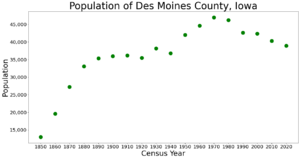Des Moines County, Iowa facts for kids
Quick facts for kids
Des Moines County
|
|
|---|---|
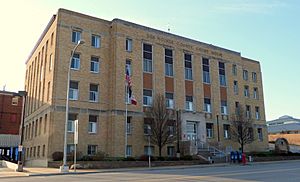
Des Moines County Courthouse
|
|
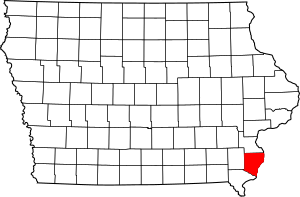
Location within the U.S. state of Iowa
|
|
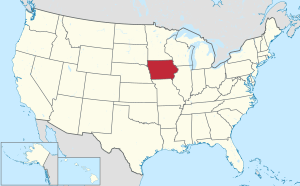 Iowa's location within the U.S. |
|
| Country | |
| State | |
| Founded | 1834 |
| Named for | Des Moines River |
| Seat | Burlington |
| Largest city | Burlington |
| Area | |
| • Total | 430 sq mi (1,100 km2) |
| • Land | 416 sq mi (1,080 km2) |
| • Water | 14 sq mi (40 km2) 3.2% |
| Population
(2020)
|
|
| • Total | 38,910 |
| • Estimate
(2023)
|
38,253 |
| • Density | 90.5/sq mi (34.9/km2) |
| Time zone | UTC−6 (Central) |
| • Summer (DST) | UTC−5 (CDT) |
| Area code | 319 |
| Congressional district | 1st |
Des Moines County is located in the U.S. state of Iowa. As of the 2020 census, the population was 38,910. The county seat and largest city is Burlington. It is one of Iowa's two original counties along with Dubuque County; both were organized by the Michigan Territorial legislature in 1834. Des Moines County is part of the Burlington, IA–IL Micropolitan Statistical Area.
Des Moines County should not be confused with the city of Des Moines, which is the capital of Iowa. Des Moines County sits on Iowa's eastern border alongside the Mississippi River. The city of Des Moines is in Polk County in central Iowa. Both places derive their name from the Des Moines River, which flows through the city of Des Moines and originally flowed through the county. When the county was divided early in Iowa's history, the river ended up further west, forming the border between Lee County, Iowa and the state of Missouri.
Contents
History
At an extra session of the Sixth Legislative Assembly of Michigan Territory held in September 1834, the Iowa District was divided into two counties by running a line due west from the lower end of Rock Island in the Mississippi River. The territory north of this line (which started just south of the present-day Davenport) was named Dubuque County, and all south of it was Demoine County. It was named after the Des Moines River. From July 3, 1836, until July 3, 1838, Des Moines County was part of Wisconsin Territory. The county underwent various border changes during this time. July 4, 1838, the named county became part of Iowa Territory (later the state of Iowa).
The current Des Moines County Court House was completed in 1940. The Iowa Army Ammunition Plant was also established in 1940.
Geography
According to the U.S. Census Bureau, the county has a total area of 430 square miles (1,100 km2), of which 416 square miles (1,080 km2) is land and 14 square miles (36 km2) (3.2%) is water. The Mississippi River forms the east border; Skunk River, the south border; and the county is drained by Flint Creek.
Major highways
Transit
- Burlington station
- Burlington Urban Service
Airport
The Southeast Iowa Regional Airport (IATA code BRL), is located on the southern side of Burlington.
Adjacent counties
- Louisa County (north)
- Hancock County, Illinois (southeast)
- Henderson County, Illinois (east)
- Lee County (south)
- Henry County (west)
Demographics
| Historical population | |||
|---|---|---|---|
| Census | Pop. | %± | |
| 1850 | 12,988 | — | |
| 1860 | 19,611 | 51.0% | |
| 1870 | 27,256 | 39.0% | |
| 1880 | 33,099 | 21.4% | |
| 1890 | 35,324 | 6.7% | |
| 1900 | 35,989 | 1.9% | |
| 1910 | 36,145 | 0.4% | |
| 1920 | 35,520 | −1.7% | |
| 1930 | 38,162 | 7.4% | |
| 1940 | 36,804 | −3.6% | |
| 1950 | 42,056 | 14.3% | |
| 1960 | 44,605 | 6.1% | |
| 1970 | 46,982 | 5.3% | |
| 1980 | 46,203 | −1.7% | |
| 1990 | 42,614 | −7.8% | |
| 2000 | 42,351 | −0.6% | |
| 2010 | 40,325 | −4.8% | |
| 2020 | 38,910 | −3.5% | |
| 2023 (est.) | 38,253 | −5.1% | |
| U.S. Decennial Census 1790-1960 1900-1990 1990-2000 2010-2018 |
|||
2020 census
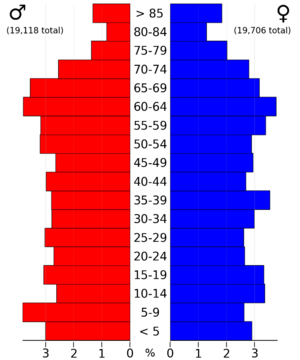
The 2020 census recorded a population of 38,910 in the county, with a population density of 91.615/sq mi (35.373/km2). 94.26% of the population reported being of one race. 82.03% were non-Hispanic White, 6.51% were Black, 3.20% were Hispanic, 0.20% were Native American, 1.04% were Asian, 0.06% were Native Hawaiian or Pacific Islander and 6.97% were some other race or more than one race. There were 18,782 housing units of which 16,751 were occupied.
| Race | Num. | Perc. |
|---|---|---|
| White (NH) | 32,753 | 84.2% |
| Black or African American (NH) | 2,501 | 6.43% |
| Native American (NH) | 67 | 0.2% |
| Asian (NH) | 398 | 1.02% |
| Pacific Islander (NH) | 21 | 0.05% |
| Other/Mixed (NH) | 1,925 | 5% |
| Hispanic or Latino | 1,245 | 3.2% |
2010 census
The 2010 census recorded a population of 40,325 in the county, with a population density of 96.9002/sq mi (37.4134/km2). There were 18,535 housing units, of which 17,003 were occupied.
Communities
Cities
Census-designated places
- Augusta
- Beaverdale
- Kingston
- Oak Hills
- Sperry
- Yarmouth
Other unincorporated communities
Townships
- Benton
- Concordia
- Danville
- Flint River
- Franklin
- Huron
- Jackson
- Pleasant Grove
- Tama
- Union
- Washington
- Yellow Springs
Population ranking
The population ranking of the following table is based on the 2020 census of Des Moines County.
† county seat
| Rank | City/Town/etc. | Municipal type | Population (2020 Census) |
|---|---|---|---|
| 1 | † Burlington | City | 23,982 |
| 2 | West Burlington | City | 3,197 |
| 3 | Mediapolis | City | 1,688 |
| 4 | Beaverdale | CDP | 880 |
| 5 | Danville | City | 927 |
| 6 | Middletown | City | 363 |
See also
 In Spanish: Condado de Des Moines para niños
In Spanish: Condado de Des Moines para niños



